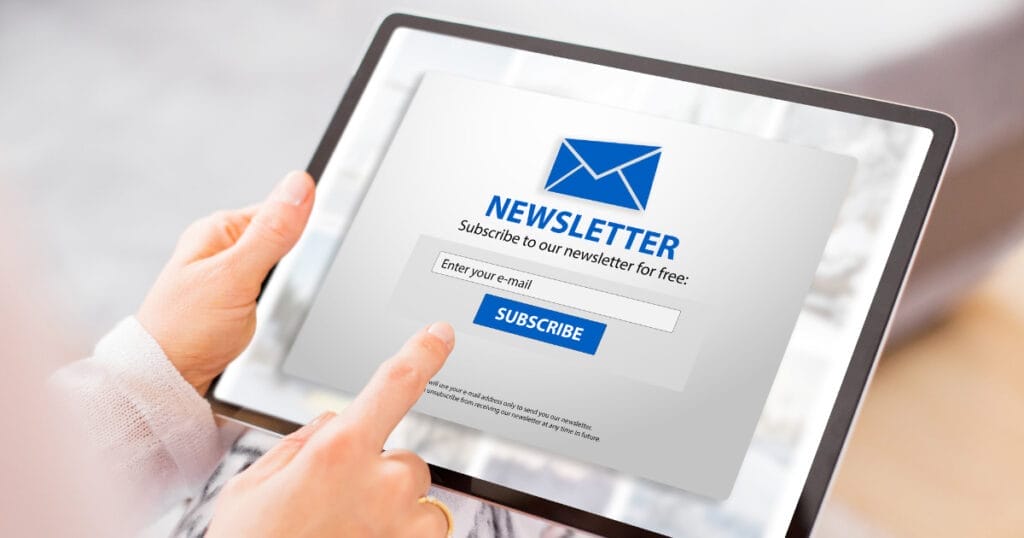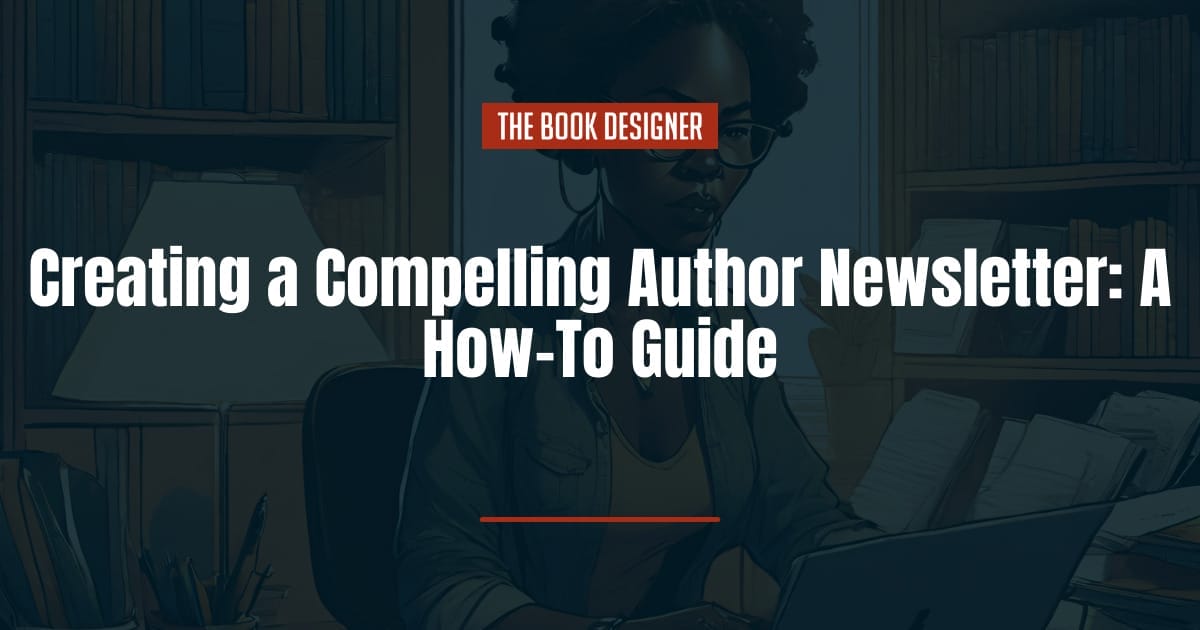Author newsletters and great marketing strategies go hand in hand. Newsletters provide an opportunity for authors to:
- Connect with their readers
- Share updates on their lives, new books, etc.
- Inform them about upcoming sales
- Build an email list
- Share book excerpts and other writing
This article will cover the steps necessary to create an author newsletter, how to format them, popular hosts to try, and what should be included in each. If that sounds interesting, keep reading.
In this article, we’ll cover what you need to know to start your own author newsletter:
The Author Newsletter
In the early days of the internet (ahem), author newsletters were nothing more than a simple update that you’d send out to people on your personal email contact list. Modern email marketing is much more sophisticated and streamlined. Gone are the days of boring, static emails with a big block of text with a couple of random pictures thrown in to make things interesting. Today’s newsletters are packed with personality and depending on the brand, can include everything from A to Z.
Over the last two decades, email marketing companies have popped up like daisies, providing a simple way for anyone on any budget to create a professional author newsletter. This is good news for authors who need budget flexibility and the ability to grow their newsletter over time as their brand grows.
Beyond offering an easy way to design a newsletter (most companies provide templates), email lists can be segmented so recipients only receive the pieces of information that interest them. You can create specific marketing campaigns to increase brand awareness, and advanced reporting gives you an in-depth view of what’s going on behind the scenes and where you may need to improve.
So why isn’t every author sending out a newsletter? I’m not sure. Email marketing is one of the best ways to reach the people who want to hear from you. It’s not like social media where you have to depend on secret algorithms to reach your audience or snail mail that can be cost-prohibitive. Yet, many authors are not taking advantage of the opportunities that a great author newsletter can create for their brand.

Author newsletters are not about spamming people. No one wants to receive unwanted emails begging you to buy their product or service. A professional author newsletter creates a bridge of communication between people who enjoy reading your books and want to connect.
If you’ve ever heard a professional marketer talk about building an audience, you will likely hear them say “Build your email list.” I’ve yet to hear someone who understands the power of email marketing recommend spending all of your time and resources on social media.
When it comes to social media, you are basically leasing your contact list because you are using their platform on their terms, so the platform determines who sees your posts or not. And now more than ever, social media platforms are so saturated that buying ads or “boosting posts” is the only way to guarantee that someone will see your message, and these are the people who actually follow you and say they want to hear from you.
On the other hand, an email list is what you own—figuratively, of course, but it’s still better than leasing. Having your own email list allows you to talk directly to people who have signed up and opted in to receive your emails. They’ve given you permission to knock on their email inbox and share what’s going on in your universe. You’re not forcing them to receive your emails, they’ve asked, and when they’re no longer interested they can unsubscribe.
So there’s the argument for having your own email list. Now, how do you get started?
Email Marketing 101: How to Get Started
Creating an author newsletter is as simple as creating an account with an email marketing company (or platform), creating an opt-in to add to your website, and uploading your contact list (those who’ve given you expressed permission to email them.)
Once you have your account set up, you can select a template to build on or design one yourself (or hire someone). From there, you plug in your content and press “send.”
Now you still have to come up with amazing content that your readers will be interested in, but the process to get started is a simple one.
Email Marketing Companies
There are too many email marketing companies to mention here, but some of the more popular, author-friendly ones are listed below along with their pricing:
Mailchimp: starting at $0/ month for 500 contacts and up to 1,000 emails sent per month
Substack: free for writers. Substack gets 10% of subscription sales from your readers.
Mailerlite: starting at $0/month for 1,000 contacts and up to 12,000 emails sent per month
Flodesk: One flat rate of $35/month for unlimited subscribers and all features (except e-commerce).
When you’re just starting to build your email list, you don’t have to go with the most expensive service provider with all the bells and whistles. You’ll pay for a lot of services that you don’t need. Go with a company that is reasonably priced (or free) that can accommodate the number of subscribers that you have. Once working with the company is no longer cost-effective or you want to upgrade the look of your author newsletter and add more features, move your contact list to another platform.
Author Newsletter Strategy
It’s Not About You
I know that sounds like a strange thing to say since you’re the author and readers are signing up for your newsletter, but it’s true. The newsletter is about your audience and their expectations. Before you decide what to write about, ask yourself why your subscribers really signed up. Whether you’re a romance, thriller, mystery, or nonfiction writer, your subscribers want more of that thing that makes you unique.
Know your audience
How do you get to know your readers? Ask them. Give them an open invitation to reply to your newsletter and tell you what they want to read. You may assume it’s one thing and find out it’s something totally different. Some readers might be interested in your writing process, while others may want to know what’s on your bookshelf and what you’d recommend in a specific genre.
Some authors I subscribe to share bits and pieces of their family life while others focus on the art of writing and how they do what they do. The first type resonates with my lifestyle side, while the other type of writer resonates with my career side. Both are useful, but if those same authors switched content, I might not be interested. So, know your audience and create a strategy around what they want and what you are comfortable sharing.
Be Consistent
The length of your author newsletter isn’t as important as consistency. Once you know what type of content works best for your audience, provide that content on a regular basis in a consistent format. Whether it’s once a week or once a month, if readers know when they’ll hear from you, they will not be surprised or turned off when your newsletter hits their inbox. There’s nothing like receiving a newsletter after a year that starts with, “I know it’s been a long time since my last newsletter, but…”
Tell Readers What to Expect
Both your newsletter sign-up and your newsletter introduction should tell readers what to expect so that there’s no confusion about what they’re signing up for. It can be something as simple as:
In my bi-monthly newsletter, I’ll share my writing journey as well as sneak peeks of my latest books. If you’re an author looking for writing how-tos or a thriller novel enthusiast who wants to know more about the inspiration behind the characters I create, this newsletter is for you. I’m happy you’re walking this journey with me. Feel free to unsubscribe at any time.
Final Thoughts
An author newsletter is one of those gems in an author’s journey that shouldn’t be overlooked. It provides a great opportunity to get to know your readers and share your writing in a more personalized way. Social media has its purpose, but email marketing puts the power of connecting directly with your readers into your hands. Make no mistake, email marketing is a long game, but when done right, it has staying power. So, be consistent, transparent, and a good listener. Pay close attention to what’s not working and be flexible enough to make adjustments when necessary.




